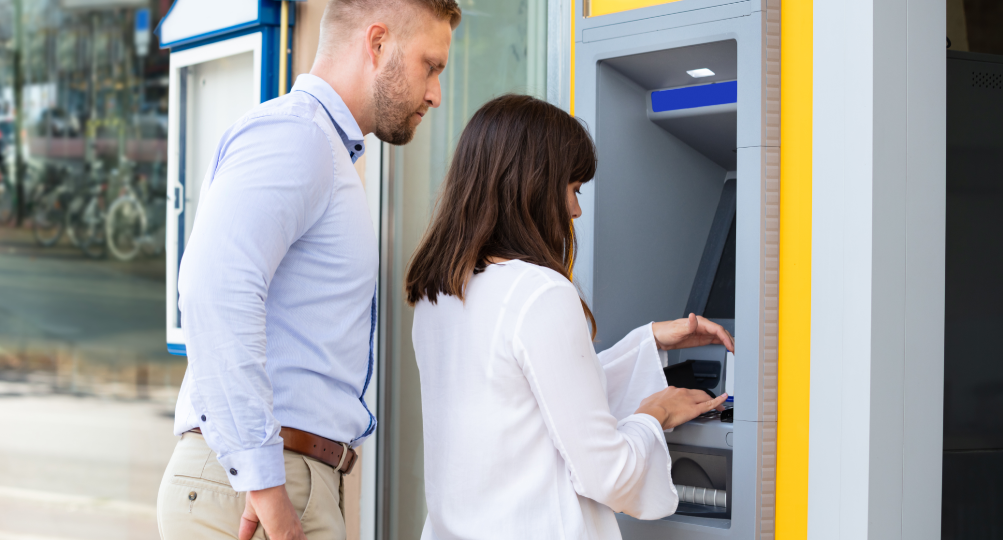
What Is Shoulder Surfing? How Does It Affect Cybersecurity
In today’s digital world, sensitive data such as financial information, personal information, and corporate secrets are primarily protected by technology. However, the increasing reliance on technology has made our personal and sensitive information vulnerable to theft by malicious actors. One of the tactics used by hackers to gain access to such information is shoulder surfing.
Shoulder surfing is a form of visual hacking, where an attacker looks over a victim’s shoulder to gain access to sensitive information such as passwords, PINs, and other confidential information. This type of attack can occur in a variety of settings, such as public places like coffee shops or airports, or even in the workplace. The attacker may use techniques such as binoculars or cameras to capture the victim’s information.
Shoulder surfing attacks can have severe consequences, ranging from identity theft to financial losses. It is crucial to take preventive measures to protect against such attacks.
Overview Of Shoulder Surfing
Shoulder surfing is a term used to describe a malicious technique that cyber attackers use to steal sensitive and confidential information. This technique involves spying on an individual to gather their private information by looking over their shoulder as they enter their credentials, listening to their conversations, or capturing their keystrokes using hidden cameras or keyloggers.
This technique is most commonly observed in crowded public places where cybercriminals can easily blend in with the crowd and position themselves near their victim. They may use sophisticated tools such as video cameras, binoculars, CCTV, and spy cameras to capture the victim’s personal data without their knowledge.
The potential consequences of shoulder surfing are quite severe, as it can lead to a breach of data confidentiality. Once attackers obtain the victim’s personal information, they can gain unauthorized access to sensitive systems and networks, leading to identity theft, financial losses, and other malicious activities.
This poses a significant threat to cyber-security, and individuals and organizations should take measures to protect themselves against it. It is important to ensure that sensitive information is not displayed in public, and to always be aware of one’s surroundings. One should also take necessary precautions such as using privacy screens or typing passwords in a manner that cannot be easily observed.
How Does It Happen In Cyberspace?
Shoulder surfing is a term used to describe a malicious technique that cyber attackers use to steal sensitive and confidential information. This technique involves spying on an individual to gather their private information by looking over their shoulder as they enter their credentials, listening to their conversations, or capturing their keystrokes using hidden cameras or keyloggers.
This technique is most commonly observed in crowded public places where cybercriminals can easily blend in with the crowd and position themselves near their victim. They may use sophisticated tools such as video cameras, binoculars, CCTV, and spy cameras to capture the victim’s personal data without their knowledge.
The potential consequences of shoulder surfing are quite severe, as it can lead to a breach of data confidentiality. Once attackers obtain the victim’s personal information, they can gain unauthorized access to sensitive systems and networks, leading to identity theft, financial losses, and other malicious activities.
This poses a significant threat to cyber-security, and individuals and organizations should take measures to protect themselves against it. It is important to ensure that sensitive information is not displayed in public, and to always be aware of one’s surroundings. One should also take necessary precautions such as using privacy screens or typing passwords in a manner that cannot be easily observed.
Shoulder surfing is one method used by hackers to obtain users’ private information, which might pose a major threat to such data. It can happen in cyberspace in a variety of ways, including:
1. Public Wi-Fi networks:
Shoulder surfing is a prevalent technique used by cyber attackers to steal sensitive information, and one of the most common ways this can happen is through public Wi-Fi networks. These networks are often unsecured, making them vulnerable to malicious activities.
Attackers can use packet sniffing software to intercept and capture network traffic, which can provide them with access to information such as usernames, passwords, and other sensitive data. This is a significant threat to cyber-security, as attackers can use this information to gain unauthorized access to networks and systems.
Another tactic used by attackers is setting up fake Wi-Fi hotspots to trick users into connecting to their network. Once connected, they can monitor the victim’s online activities and steal their confidential information. This can result in identity theft, financial loss, and other harmful consequences.
It is important to take necessary precautions when using public Wi-Fi networks to protect yourself from these threats. One of the most effective ways is to avoid using public Wi-Fi networks altogether, especially for sensitive transactions such as online banking or accessing confidential work documents.
If you must use a public Wi-Fi network, ensure that it is secured with a strong password and encryption. Additionally, you can use a virtual private network (VPN) to encrypt your online activities and protect your data from prying eyes.
2. Phishing Scams:
Phishing is a common tactic used by attackers to obtain sensitive information from unsuspecting victims. It involves sending fraudulent emails or messages that appear to be from legitimate sources, such as banks or other trusted entities.
These messages often contain links to clone websites that resemble the original ones, luring users into entering their private credentials. These websites can be convincing, with logos, layouts, and wording that match the legitimate ones, making it difficult for users to detect the fraud.
Once users enter their private information on these sites, attackers can gain access to it and use it for malicious activities such as identity theft, financial fraud, and other harmful activities.
Phishing attacks can have severe consequences for individuals and organizations, as they can compromise sensitive data and cause financial losses. It is essential to be vigilant and cautious when receiving emails or messages from unknown sources and to verify the authenticity of links before clicking on them.
To protect yourself from phishing attacks, it is recommended that you use multi-factor authentication, keep your software and security tools up to date, and avoid sharing sensitive information over email or messages.
3. Social engineering:
Social engineering is a technique used by cyber attackers to conduct shoulder surfing by tricking individuals into divulging their private information or performing activities that can compromise their security. It involves exploiting human behavior and psychology to gain access to sensitive data.
One common tactic used by attackers is to pose as a legitimate authority, such as a tech support or service provider, to gain access to a user’s device or ask for their password. They can use various methods such as phone calls, emails, or social media messages to make their requests seem legitimate.
Another tactic used by attackers is to create a sense of urgency or fear, such as threatening to suspend an account or warning of a security breach. This can pressure users into providing their private information without questioning the authenticity of the request.
Social engineering attacks can be difficult to detect, as they often rely on exploiting human emotions and trust. It is essential to be cautious and skeptical when receiving requests for sensitive information and to verify the authenticity of the request before complying.
To protect yourself from social engineering attacks, it is recommended that you educate yourself on the common tactics used by attackers, be cautious when receiving requests for sensitive information, and use multi-factor authentication to protect your accounts.
4. Physical access:
Physical access is one of the most direct ways attackers can use shoulder surfing to gain access to sensitive information. It involves physically accessing a device and installing spyware or keyloggers to capture private data. This can occur if users leave their devices unattended in a public place or if someone gains access to their home or office.
Attackers can also monitor victims physically by observing them when using an ATM or their devices, such as laptops or smartphones. They can also use hidden cameras or recording devices to capture keystrokes or screen captures, even in private spaces like homes or offices.
Physical access attacks can have severe consequences, as they can provide attackers with unrestricted access to sensitive data, including personal information, financial details, and passwords. Attackers can use this information to perform various malicious activities such as identity theft, financial fraud, or data breaches.
To protect yourself from physical access attacks, it is recommended that you keep your devices with you at all times, especially in public places. You should also use strong passwords, enable encryption, and regularly update your security software to prevent spyware or malware from being installed on your device.
Why Do Hackers Use Shoulder Surfing?
Shoulder surfing is a highly effective method for hackers to obtain sensitive information from their targets. It is a social engineering tactic that involves exploiting human vulnerabilities to distract victims while stealing their information. One of the significant advantages of shoulder surfing is that it does not require sophisticated technical skills or tools, making it accessible to even novice hackers.
Hackers can use a variety of techniques to perform shoulder surfing, including physically observing their target’s computer screen, listening to their conversations, or even using hidden cameras or keyloggers to capture their keystrokes. These methods allow hackers to obtain sensitive information such as login credentials, credit card numbers, and other private data without being detected.
Another advantage of shoulder surfing is that it carries a low risk for the attacker. If caught in the act, the hacker can quickly walk away and target another victim. Additionally, it is difficult to prove that someone was shoulder surfing, as there is often no trace left behind.
Moreover, shoulder surfing attacks can occur anywhere, including public places like cafes, airports, and hotels, making them a significant threat to cybersecurity. Hackers can use public Wi-Fi networks or fake Wi-Fi hotspots to intercept and capture network traffic and steal sensitive information from unsuspecting victims.
To protect against shoulder surfing attacks, individuals and organizations should practice good cybersecurity hygiene, including the use of strong passwords, encryption, and security software. They should also be aware of their surroundings, especially in public places, and avoid sharing sensitive information in crowded or unsecured locations.
Consequences Of Shoulder Surfing?
The success and consequences of a shoulder surfing attack largely depend on the amount and nature of information the attacker obtains. For instance, if the attacker gains access to the victim’s social media accounts, credit card details, and bank information, the consequences can be severe. One of the most significant consequences of shoulder surfing attacks is identity theft. Attackers can use the stolen information for fraudulent activities, leading to identity theft.
Identity theft is a severe crime that can have long-lasting consequences for the victim. Attackers can use stolen information like social security numbers to open new credit accounts, apply for loans, and access health insurance. If attackers have access to a victim’s health insurance, they can use it to receive medical care or apply for government benefits under the victim’s name.
Furthermore, attackers can use the stolen information to wipe out the victim’s finances by taking out loans in their name or making fraudulent purchases. This can lead to severe financial damage, leaving the victim in massive debt and with a damaged credit score. The victim may also face legal troubles, and it can be challenging to clear their name and restore their creditworthiness.
In addition to identity theft, attackers can also use the information obtained from shoulder surfing to conduct other malicious activities. For instance, they can launch phishing attacks, distribute malware, and engage in other forms of cybercrime. Overall, shoulder surfing attacks pose a significant threat to individuals and organizations alike and should be taken seriously to prevent serious financial and reputational damage.
Examples Of Shoulder Surfing
It’s important to be aware of the various scenarios where shoulder surfing can occur. Often, users are not aware of the risks and fail to take necessary precautions to protect their sensitive information.
One scenario where shoulder surfing can happen is when users are logging into their bank accounts or other sensitive apps in public places. This could be a coffee shop, airport, or any other place with public Wi-Fi. Attackers can easily use packet sniffing software to intercept and capture network traffic and gain access to information such as usernames, passwords, and other sensitive information.
Another common scenario is when users pay for things with a debit or credit card in-store. Attackers can either physically observe the card details being entered, or they can use a skimming device to capture the information from the card’s magnetic stripe. This information can then be used for fraudulent activities.
Additionally, people can fall victim to shoulder surfing by providing private information unconsciously in conversation with someone in public loudly. For example, discussing personal information like account details or passwords over the phone in a public place.
It’s also important to note that accessing corporate systems remotely in public locations, such as airports or cafes, can also pose a risk of shoulder surfing. Attackers can use various tactics such as shoulder surfing, eavesdropping or installing spyware to capture sensitive information.
Finally, using ATMs in public places can also put individuals at risk. Attackers can install skimming devices on ATMs or physically observe users entering their PIN numbers to gain access to their accounts.
Ten Ways To Prevent Shoulder Surfing
After discussing it, many people were concerned about shoulder surfing. Following basic best practices that can keep your sensitive information safe is vital to preventing shoulder surfing. Here are 10 strategies for avoiding shoulder surfing:
1. Use privacy filters:
Privacy filters, also referred to as privacy screens, are a physical layer of protection that can be attached to the surface of your device’s screen. These filters are specifically designed to restrict the viewing angle of your screen, making it nearly impossible for someone to see the contents of your screen from any angle except straight-on. They use advanced technology to ensure that the display is only visible to the person sitting directly in front of the screen.
One of the primary benefits of privacy filters is that they provide an additional layer of security for your sensitive information. They help to prevent prying eyes from seeing your private data and sensitive information, such as your login credentials, credit card details, and personal messages.
Privacy filters can be particularly useful in crowded places like coffee shops, airports, and trains, where there is a high chance of shoulder surfing and snooping. By using a privacy filter, you can work on your laptop or use your mobile phone without worrying about someone stealing your information.
In addition to providing added security, privacy filters also protect your screen from scratches and fingerprints. They are available in various sizes and types, suitable for a wide range of devices such as laptops, smartphones, and tablets.
While privacy filters are an excellent option for those who value their privacy and security, they are not foolproof. It is still essential to remain vigilant and cautious when using your devices in public places. Additionally, it is crucial to keep your devices locked with a strong password or biometric authentication, and to avoid using public Wi-Fi networks whenever possible.
2. Use a password manager:
Password managers are valuable tools that can help users create, store, and retrieve complex passwords for various accounts. These tools encrypt passwords and store them in a secure location, making it easy for users to access them when needed. With a password manager, users don’t have to remember multiple complex passwords for different accounts. Instead, they can use a single master password to access the password manager, which then automatically logs them in to their desired account.
The benefit of using a password manager is that it ensures that users have unique, strong, and complex passwords for each account. This makes it more difficult for attackers to crack passwords and gain unauthorized access. Additionally, it saves users time and effort, as they don’t have to remember and type in passwords manually.
However, it’s important to note that password managers also come with their own set of risks. If the master password is weak or compromised, it can lead to all other passwords being exposed. Users should ensure that they use a strong and unique master password, and also enable two-factor authentication for added security.
Furthermore, users should choose a reputable and trustworthy password manager provider, as some password managers may be vulnerable to hacking or data breaches. It’s recommended to research and choose a password manager that has a good track record of security and user privacy.
3. Use two-factor authentication:
Two-factor authentication is a security feature that provides an additional layer of protection to the user’s account. In addition to the usual username and password, it requires users to provide a second form of identification to access their account. This second form can be in the form of a text message or a phone call, which will provide the user with a unique code that needs to be entered to gain access to the account.
This feature can be used on various platforms, such as banking apps, email accounts, social media platforms, and other online services. It is an effective way to prevent unauthorized access to the user’s account even if the attacker has access to the login credentials.
Two-factor authentication works by verifying the user’s identity in two different ways. Firstly, the user needs to provide the login details, which they would usually use to access their account. Secondly, they need to provide a second form of authentication, which can be a code sent to their mobile device, an email with a unique link, or a phone call. Only after successful verification of both the user’s login details and the second form of authentication, the user can access their account.
Using two-factor authentication can significantly reduce the risk of hacking, as it adds an extra layer of protection. Even if an attacker manages to obtain the user’s login details, they won’t be able to log in without the second form of authentication, which is unique and valid for a limited time. Therefore, it is an effective way to keep the user’s sensitive data secure.
4. Use physical barriers:
When entering sensitive information, it is crucial to take precautions to prevent shoulder surfing attacks. One of the best ways to protect your information is to use physical barriers like your body, hand, or a piece of paper to hide the information from prying eyes. This way, it will be much harder for anyone nearby to observe what you’re typing.
For example, if you’re entering your password on a public computer or logging into your bank account at a cafe, try to position yourself in a way that obstructs the view of anyone standing or sitting behind you. You can use your hand to cover the keyboard as you type, or hold a piece of paper between your eyes and the screen. This will ensure that any sensitive information you’re entering remains private and secure.
It’s also important to be aware of your surroundings and any suspicious activity. If you notice someone standing too close to you or trying to peek over your shoulder, be sure to move or ask them to give you some space. Additionally, avoid entering sensitive information in public places if possible and wait until you have privacy to enter it. Taking these simple steps can go a long way in protecting your information from shoulder surfers and other cyber attackers.
5. Log in with Biometrics:
Enabling biometric authentication is a highly recommended security measure for users to protect their devices and online accounts. Biometric authentication uses unique biological characteristics, such as fingerprints or facial recognition, to grant access to the device or account. By using biometric authentication, users can significantly increase the security of their devices and online accounts as it is difficult for hackers to replicate or obtain these unique biological characteristics.
In addition to being a secure method of authentication, biometric authentication is also a convenient way for users to access their devices and online accounts. Instead of typing in a password or passcode, users can simply use their fingerprint or facial recognition to log in quickly.
However, it is important to note that biometric authentication should not be used as the sole method of authentication. Users should also have a strong and unique password, enable two-factor authentication, and take other necessary security measures to ensure the safety of their devices and online accounts.
6. Avoid Public Networks:
Public Wi-Fi networks are often unsecured and can easily be compromised by hackers, making it a prime target for man-in-the-middle attacks. In such attacks, the attacker intercepts the communication between the user and the network to gain access to sensitive information. This is why users are strongly advised to avoid using public Wi-Fi networks and instead use their own phone’s hotspot for internet connectivity whenever possible.
If using public Wi-Fi is unavoidable, users should take additional precautions to protect themselves. One way to secure the connection is to use a Virtual Private Network (VPN) which can encrypt the network connection and make it difficult for scammers and hackers to access and intercept the user’s data.
Another precautionary measure users can take is to ensure that the websites they visit have “https” in the URL, which indicates that the website has SSL encryption. SSL encryption ensures that any data transmitted between the user’s device and the website is encrypted, making it difficult for attackers to intercept and read the information.
7. Be cautious of phishing scams:
Phishing scams are a prevalent method that cybercriminals use to acquire sensitive information. In a phishing scam, attackers will typically send out unsolicited emails, texts, or phone calls that appear to be from legitimate sources such as banks, social media sites, or government agencies. These messages will usually ask for personal information such as usernames, passwords, credit card numbers, or other sensitive data.
To protect oneself from phishing scams, it’s essential to be cautious of any unsolicited communication that asks for personal information. Always verify the sender’s identity and the authenticity of the message before responding or clicking on any links.
Some common signs of a phishing scam include:
- Urgent language, such as threats of account closure or warnings of security breaches.
- Requests for personal information, such as passwords, social security numbers, or credit card information.
- Misspelled words or grammatical errors in the message.
- Suspicious links that may redirect to fake login pages or malware-infected websites.
It’s also essential to keep all software, including web browsers and anti-virus programs, up-to-date to prevent cybercriminals from exploiting any vulnerabilities. By being vigilant and taking precautions, individuals can protect themselves from falling victim to phishing scams and safeguard their sensitive information.
8. Use strong passwords:
It is highly recommended to use strong, unique passwords for each of your accounts to ensure maximum security. Using easily guessable information such as your birthdate or pet’s name makes it easier for hackers to guess your password and access your accounts. Therefore, you should use a combination of letters, numbers, and symbols to make your password more complex and difficult to guess. Additionally, it is important to avoid using the same password for multiple accounts, as this increases the risk of your accounts being compromised if one password is discovered.
Using a password manager is also an effective way to create strong and unique passwords for each of your accounts. These tools generate and store complex passwords, removing the need for you to remember them all. Another benefit is that you won’t be tempted to reuse the same password across multiple accounts, as the password manager takes care of remembering them for you.
In addition to creating strong passwords, it is also essential to update them regularly. This reduces the risk of your password being compromised over time. Furthermore, it is recommended that you use multi-factor authentication whenever possible to add an extra layer of protection to your accounts. This means that even if someone guesses or steals your password, they will still need to provide additional information to access your accounts.
9. Be vigilant:
In order to protect your sensitive information, it is important to remain vigilant and take necessary precautions. Shoulder surfing can take place anywhere in public, so being aware of your surroundings is crucial. By staying alert, you can minimize the risk of someone stealing your personal data. If you notice someone acting suspiciously or attempting to observe your screen, it is important to take immediate action and move to a more secure location. This can prevent your sensitive information from being compromised.
Additionally, it is recommended to use privacy filters on your devices, which can narrow the viewing angle of your screen and prevent others from viewing your screen from any angle except straight-on. Another important precaution is to use strong and unique passwords for each account, and avoid using easily guessable information such as your birthdate or pet’s name. Users are also advised to enable biometric authentication and two-factor authentication for added security. Furthermore, public Wi-Fi networks are vulnerable to hacking and infiltration, so it is best to avoid them and use phone hotspots or VPNs to encrypt network connections.
Overall, being proactive and taking the necessary steps to protect your sensitive information can go a long way in preventing cyber attacks and identity theft.
10. Keep your device up to date:
Security patches are crucial in maintaining the security of your device. They are often included in software updates that address known vulnerabilities and fix potential security issues. By keeping your device’s operating system and apps up to date, you can ensure that your device is protected against potential attacks.
Hackers and cybercriminals are always searching for vulnerabilities in popular apps and operating systems. When they find a vulnerability, they can exploit it to gain access to your device and steal sensitive information. Therefore, it’s important to regularly update your device’s software to protect against known vulnerabilities.
Software updates and security patches are often designed to fix bugs and glitches in apps and operating systems, as well as to add new features. By staying up to date with the latest updates, you can take advantage of these new features and ensure that your device is running smoothly.
Moreover, not keeping your device updated can make it more vulnerable to cyberattacks. Malicious actors often target devices that are running outdated software, as they know that these devices are more likely to have unpatched vulnerabilities that they can exploit. To avoid falling victim to cyberattacks, it’s essential to keep your device’s software up to date with the latest security patches.
Conclusion
Shoulder surfing is a dangerous practice that poses a serious threat to cyber-security, which can have devastating consequences for individuals and businesses. Therefore, it is essential to understand the risks associated with shoulder surfing and implement effective mitigation strategies.
To protect yourself and your sensitive information from prying eyes, it is vital to remain alert and aware of your surroundings when working with confidential data. This means taking proactive measures to prevent shoulder surfing attacks, such as physically blocking your screen or using privacy filters. It is also essential to avoid entering sensitive information in public places, where it is more likely to be exposed to potential attackers.
Implementing two-factor authentication, using a password manager, and enabling biometric authentication are additional steps that can help protect your sensitive information from cyber-criminals. Similarly, avoiding public Wi-Fi networks, using VPNs, and keeping your device’s operating system and apps updated with the latest security patches are other important strategies to consider.
By being mindful of these best practices, you can minimize the risks associated with shoulder surfing and other cyber-attacks, safeguard your privacy, and maintain the security of your digital assets. Remember to be vigilant, proactive, and always stay up-to-date with the latest cybersecurity best practices to stay protected from evolving threats.

















